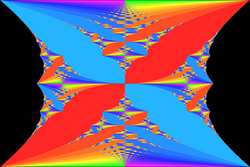Almost Mathieu operator
In mathematical physics, the almost Mathieu operator arises in the study of the quantum Hall effect. It is given by
- [math]\displaystyle{ [H^{\lambda,\alpha}_\omega u](n) = u(n+1) + u(n-1) + 2 \lambda \cos(2\pi (\omega + n\alpha)) u(n), \, }[/math]
acting as a self-adjoint operator on the Hilbert space [math]\displaystyle{ \ell^2(\mathbb{Z}) }[/math]. Here [math]\displaystyle{ \alpha,\omega \in\mathbb{T}, \lambda \gt 0 }[/math] are parameters. In pure mathematics, its importance comes from the fact of being one of the best-understood examples of an ergodic Schrödinger operator. For example, three problems (now all solved) of Barry Simon's fifteen problems about Schrödinger operators "for the twenty-first century" featured the almost Mathieu operator.[1] In physics, the almost Mathieu operators can be used to study metal to insulator transitions like in the Aubry–André model.
For [math]\displaystyle{ \lambda = 1 }[/math], the almost Mathieu operator is sometimes called Harper's equation.
The spectral type
If [math]\displaystyle{ \alpha }[/math] is a rational number, then [math]\displaystyle{ H^{\lambda,\alpha}_\omega }[/math] is a periodic operator and by Floquet theory its spectrum is purely absolutely continuous.
Now to the case when [math]\displaystyle{ \alpha }[/math] is irrational. Since the transformation [math]\displaystyle{ \omega \mapsto \omega + \alpha }[/math] is minimal, it follows that the spectrum of [math]\displaystyle{ H^{\lambda,\alpha}_\omega }[/math] does not depend on [math]\displaystyle{ \omega }[/math]. On the other hand, by ergodicity, the supports of absolutely continuous, singular continuous, and pure point parts of the spectrum are almost surely independent of [math]\displaystyle{ \omega }[/math]. It is now known, that
- For [math]\displaystyle{ 0 \lt \lambda \lt 1 }[/math], [math]\displaystyle{ H^{\lambda,\alpha}_\omega }[/math] has surely purely absolutely continuous spectrum.[2] (This was one of Simon's problems.)
- For [math]\displaystyle{ \lambda= 1 }[/math], [math]\displaystyle{ H^{\lambda,\alpha}_\omega }[/math] has surely purely singular continuous spectrum for any irrational [math]\displaystyle{ \alpha }[/math].[3]
- For [math]\displaystyle{ \lambda \gt 1 }[/math], [math]\displaystyle{ H^{\lambda,\alpha}_\omega }[/math] has almost surely pure point spectrum and exhibits Anderson localization.[4] (It is known that almost surely can not be replaced by surely.)[5][6]
That the spectral measures are singular when [math]\displaystyle{ \lambda \geq 1 }[/math] follows (through the work of Yoram Last and Simon) [7] from the lower bound on the Lyapunov exponent [math]\displaystyle{ \gamma(E) }[/math] given by
- [math]\displaystyle{ \gamma(E) \geq \max \{0,\log(\lambda)\}. \, }[/math]
This lower bound was proved independently by Joseph Avron, Simon and Michael Herman, after an earlier almost rigorous argument of Serge Aubry and Gilles André. In fact, when [math]\displaystyle{ E }[/math] belongs to the spectrum, the inequality becomes an equality (the Aubry–André formula), proved by Jean Bourgain and Svetlana Jitomirskaya.[8]
The structure of the spectrum
Another striking characteristic of the almost Mathieu operator is that its spectrum is a Cantor set for all irrational [math]\displaystyle{ \alpha }[/math] and [math]\displaystyle{ \lambda \gt 0 }[/math]. This was shown by Avila and Jitomirskaya solving the by-then famous "ten martini problem"[9] (also one of Simon's problems) after several earlier results (including generically[10] and almost surely[11] with respect to the parameters).
Furthermore, the Lebesgue measure of the spectrum of the almost Mathieu operator is known to be
- [math]\displaystyle{ \operatorname{Leb}(\sigma(H^{\lambda,\alpha}_\omega)) = |4 - 4 \lambda| \, }[/math]
for all [math]\displaystyle{ \lambda \gt 0 }[/math]. For [math]\displaystyle{ \lambda = 1 }[/math] this means that the spectrum has zero measure (this was first proposed by Douglas Hofstadter and later became one of Simon's problems).[12] For [math]\displaystyle{ \lambda \neq 1 }[/math], the formula was discovered numerically by Aubry and André and proved by Jitomirskaya and Krasovsky. Earlier Last [13][14] had proven this formula for most values of the parameters.
The study of the spectrum for [math]\displaystyle{ \lambda =1 }[/math] leads to the Hofstadter's butterfly, where the spectrum is shown as a set.
References
- ↑ Simon, Barry (2000). "Schrödinger operators in the twenty-first century". Mathematical Physics 2000. London: Imp. Coll. Press. pp. 283–288. ISBN 978-1860942303.
- ↑ Avila, A. (2008). "The absolutely continuous spectrum of the almost Mathieu operator". arXiv:0810.2965 [math.DS].
- ↑ Jitomirskaya, S.. On point spectrum of critical almost Mathieu operators. https://www.math.uci.edu/~mathphysics/preprints/point.pdf.
- ↑ Jitomirskaya, Svetlana Ya. (1999). "Metal-insulator transition for the almost Mathieu operator". Ann. of Math. 150 (3): 1159–1175. doi:10.2307/121066. Bibcode: 1999math.....11265J.
- ↑ Avron, J.; Simon, B. (1982). "Singular continuous spectrum for a class of almost periodic Jacobi matrices". Bull. Amer. Math. Soc. 6 (1): 81–85. doi:10.1090/s0273-0979-1982-14971-0.
- ↑ Jitomirskaya, S.; Simon, B. (1994). "Operators with singular continuous spectrum, III. Almost periodic Schrödinger operators". Comm. Math. Phys. 165 (1): 201–205. doi:10.1007/bf02099743. Bibcode: 1994CMaPh.165..201J. http://www.math.caltech.edu/papers/bsimon/p235.pdf.
- ↑ Last, Y.; Simon, B. (1999). "Eigenfunctions, transfer matrices, and absolutely continuous spectrum of one-dimensional Schrödinger operators". Invent. Math. 135 (2): 329–367. doi:10.1007/s002220050288. Bibcode: 1999InMat.135..329L.
- ↑ Bourgain, J.; Jitomirskaya, S. (2002). "Continuity of the Lyapunov exponent for quasiperiodic operators with analytic potential". Journal of Statistical Physics 108 (5–6): 1203–1218. doi:10.1023/A:1019751801035.
- ↑ Avila, A.; Jitomirskaya, S. (2005). "Solving the Ten Martini Problem". The Ten Martini problem. Lecture Notes in Physics. 690. pp. 5–16. doi:10.1007/3-540-34273-7_2. ISBN 978-3-540-31026-6. Bibcode: 2006LNP...690....5A.
- ↑ Bellissard, J.; Simon, B. (1982). "Cantor spectrum for the almost Mathieu equation". J. Funct. Anal. 48 (3): 408–419. doi:10.1016/0022-1236(82)90094-5.
- ↑ Puig, Joaquim (2004). "Cantor spectrum for the almost Mathieu operator". Comm. Math. Phys. 244 (2): 297–309. doi:10.1007/s00220-003-0977-3. Bibcode: 2004CMaPh.244..297P.
- ↑ Avila, A.; Krikorian, R. (2006). "Reducibility or non-uniform hyperbolicity for quasiperiodic Schrödinger cocycles". Annals of Mathematics 164 (3): 911–940. doi:10.4007/annals.2006.164.911.
- ↑ Last, Y. (1993). "A relation between a.c. spectrum of ergodic Jacobi matrices and the spectra of periodic approximants". Comm. Math. Phys. 151 (1): 183–192. doi:10.1007/BF02096752. Bibcode: 1993CMaPh.151..183L. http://projecteuclid.org/euclid.cmp/1104252049.
- ↑ Last, Y. (1994). "Zero measure spectrum for the almost Mathieu operator". Comm. Math. Phys. 164 (2): 421–432. doi:10.1007/BF02096752. Bibcode: 1993CMaPh.151..183L. http://projecteuclid.org/euclid.cmp/1104252049.
 |


